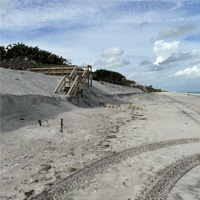 No sand influx soon for eroded Shores beaches
No sand influx soon for eroded Shores beaches
STORY BY LISA ZAHNER (Week of February 8, 2024)
The eroded beaches of Indian River Shores from John’s Island to the Tracking Station will not be getting the badly needed influx of sand residents were hoping for this winter.
There might be time to complete the work before the May 1 start of sea turtle nesting season if this were a commercial project, but there’s not enough time to cut through all the government red tape.
Turns out that instead of somehow piggybacking on the $13 million North Barrier Island sand project already underway – having the same contractors continue on south once they finish the 6.6-mile-long dune repair job which ends at the northern edge of John’s Island – the county needs to conduct a separate bidding process for the Shores project.
“Even if the permits were issued today, it wouldn’t be possible to get the bidding process done to start construction before April 30,” county spokesperson Kathleen Copeland said last week. But the permits were not issued last week. They won’t be issued this week. And next week’s not looking good either.
Why, you may ask?
Well, a new state law effective Jan. 1 required a change in the wording of the easements executed by oceanfront property owners giving the county permission to work on the non-public portion of the beach landward of the mean high-water line.
So even though Indian River Shores made a big push to get the required number of easements signed so the project could move forward – with John’s Island residents even hosting an “easement-signing party” to get the paperwork executed en masse – any easements that were not recorded by the county prior to Jan. 1 need to be completely redone. Only half of the 88 easements were recorded by Dec. 31.
Then there’s the matter of “known archaeological artifacts” buried under the beach sand at two undisclosed locations in John’s Island. As engineers were putting together the permit applications, the equivalent of a title search was completed to uncover anything the county and state officials ought to know when considering the application.
A wooden plank that surfaced in the 1970s on the beach in John’s Island was determined to be from a very old ship. At the time, a team of state archaeologists excavated the area to dig up and remove anything of cultural or historical value – even the two iron spikes and one small nail were removed from the wooden plank. But for some reason the wooden plank was re-buried in place and presumably still rests an unknown number of feet or yards below the surface.
Similarly, a piece of pottery, “half of basal part of thin Middle Period olive jar,” was found in 1968 in a different spot, by a Shores resident. Again, archaeologists excavated the area, and nothing else of value was found, other than the possibly 3,000-year-old broken pottery.
The discovery of these two “artifacts” more than 50 years ago means that the county’s beach sand permit application gets a detour through a bunch of extra government employees before the state can give the go-ahead to place sand on the beach.
First stop after the Florida Department of Environmental Protection and the U.S. Army Corps of Engineers is the Florida State Historic Preservation Office, which led to a letter to the Army Corps from the Florida Department of State recommending a “professional cultural resources assessment survey.”
“The resultant survey report should conform to the provisions of Chapter 1A-46, Florida Administrative Code, and should be sent to our office upon completion. The report will help us complete the review process and provide comments or recommendations to the permitting agency in a timely fashion,” the letter read.
The Department of State could not recommend an archaeologist, but included lists of resources where one might find someone qualified to do the job. Needless to say, this was not something that will be completed by next week.
Data from the state and federal permits, once issued, would then need to be plugged into a brand-new request for proposals. Then the RFP would be advertised with a deadline of at least 30 days, then county staff would take another two weeks or so to evaluate the proposals and make a recommendation to the Board of County Commissioners.
Once a contractor was chosen and the $6 million bid awarded – a feat which could theoretically be achieved by mid-April – production of the beach-quality sand processed to FDEP specifications would begin.
“Previous County truck-haul projects achieved a placement rate of sand of approximately 2,000 to 2,700 cubic yards per day. A volume of 4,000 cubic yards per day would require a minimum of 34 days of construction,” the Jan. 22 county beach report states. So even with the sand miners working round the clock, the material would take more than a month to prepare for transport to the beach.
Copeland said the county has kept in touch with the oceanfront property owners in the Shores to let them know why their beach will not get sand until Nov. 1 at the earliest – after the most active portion of the 2024 Atlantic Hurricane Season.
Shores Mayor Brian Foley was diplomatic on Monday when addressing the delays. “It is progressing about as quickly as we anticipated, and in fact, maybe a little quicker. These kinds of details always arise when undertaking projects of this type,” Foley said.
The Town of Indian River Shores has also sent out a bulletin updating town residents on the status of the beach replenishment project, which included a memo from Indian River County Natural Resources Director Eric Charest.
Anticipating that some HOAs or individuals might want to truck-in their own sand before time runs out on April 30, he wrote, “Oceanfront property owners that choose to pursue their own private emergency measures (such as the placement of beach quality sand) in advance of the County’s anticipated construction timeline would need to obtain an Emergency Field Permit issued from the Florida Department of Environmental Protection (FDEP).
Property owners can request a permit either through the FDEP Coastal Construction Control Line field inspector in Tallahassee or by calling the county at (772) 226-1648 for help getting an emergency permit.
“Please be assured that any measures individual property owner chooses to pursue will not impact your property’s participation in the County’s upcoming Sector 4 Dune Restoration project provided that the County’s required beach easement agreement is recorded for that property,” Charest wrote. “The County would like to extend gratitude to the local neighborhood champions of the Sector 4 Dune Restoration Project for their efforts and communications that have gone into the Project thus far.”
At least the funding seems to be in place, once the permits are issued and the sea turtles finish nesting. On Jan. 22 the county received a $2 million grant award letter from the Florida Department of Emergency Management for the Indian River Shores project. A portion of the county bed tax revenue is also used for beach replenishment.




